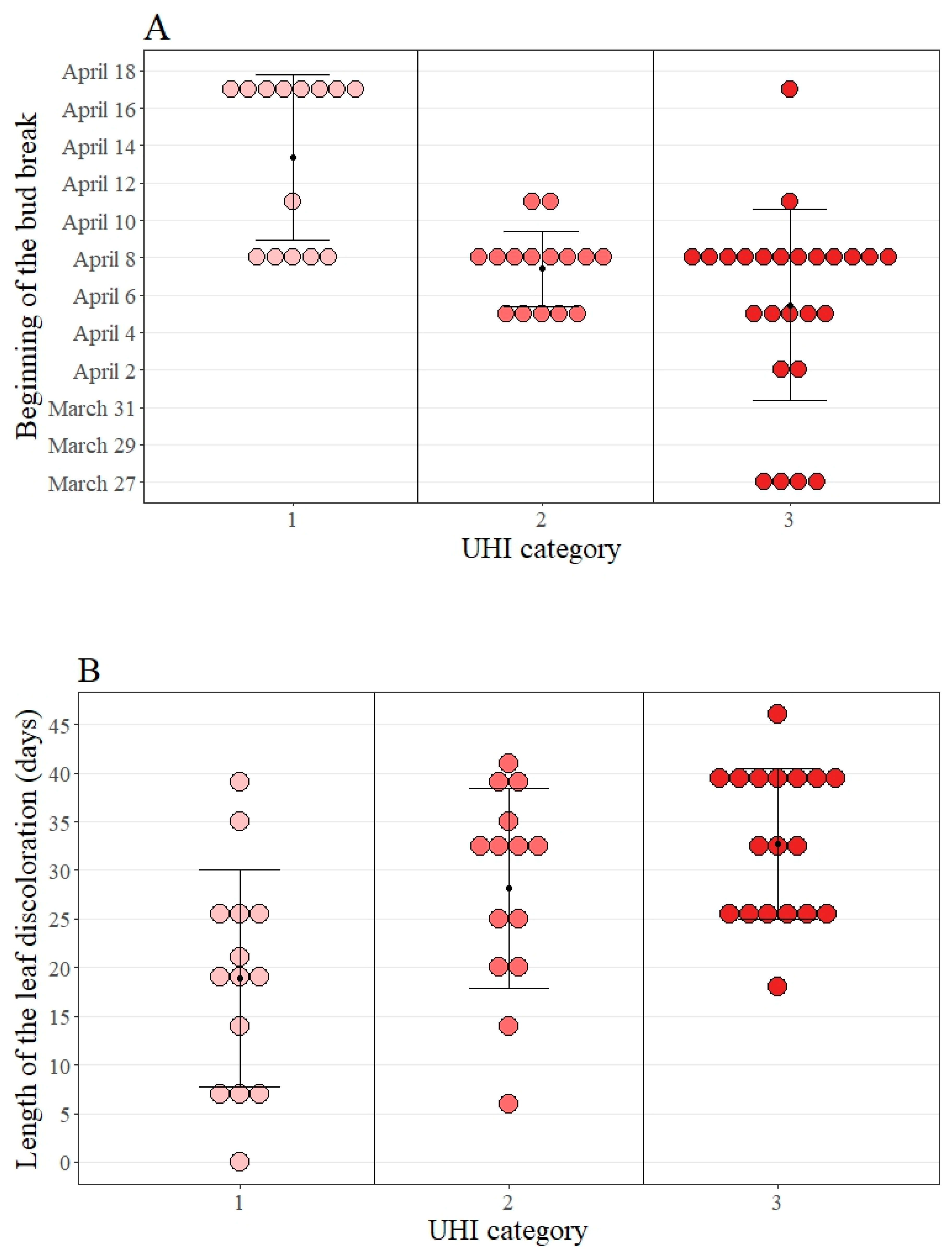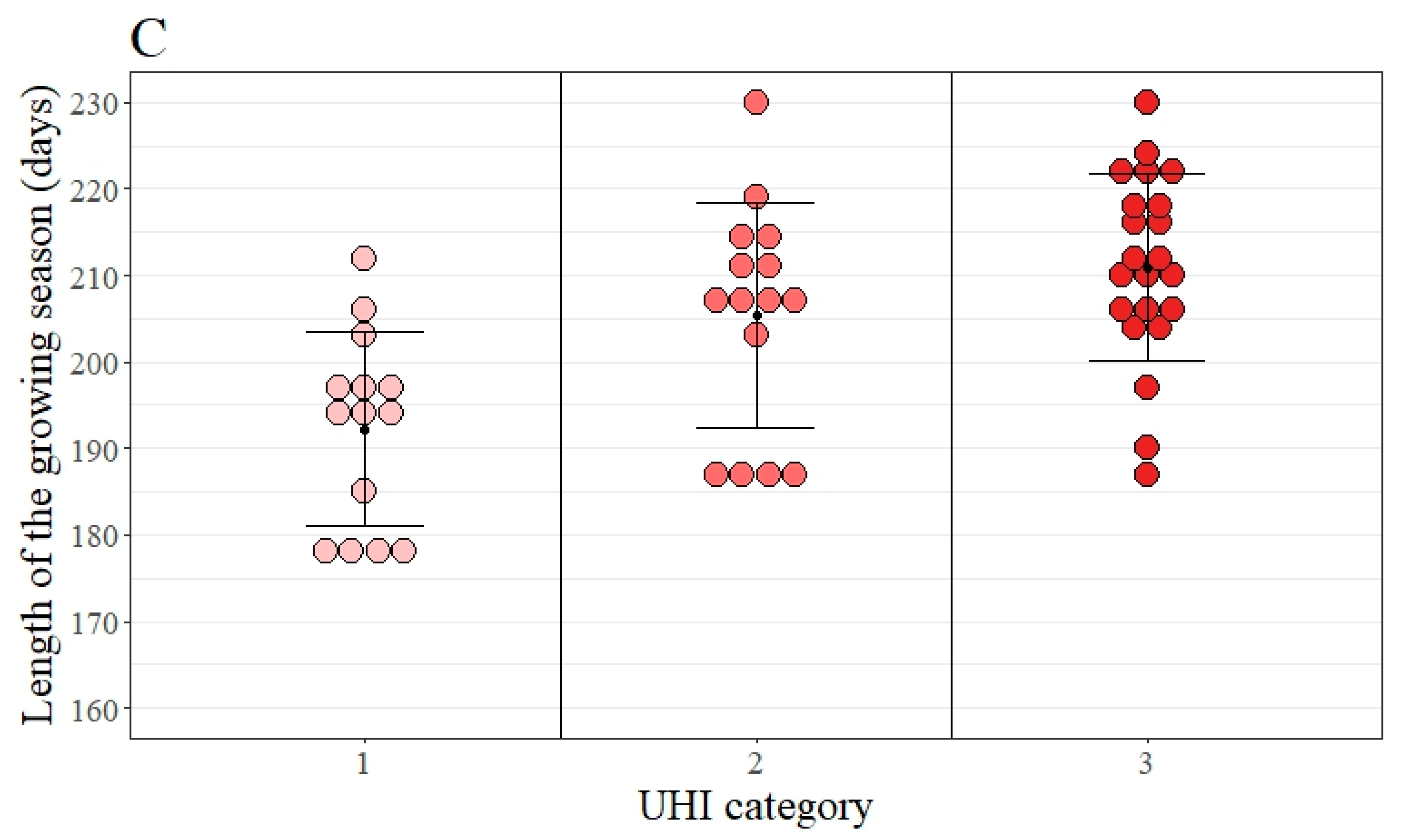Mutual Influences of Urban Microclimate and Urban Trees: An Investigation of Phenology and Cooling Capacity
Abstract
1. Introduction
2. Materials and Methods
2.1. Study Sites and Objects
2.2. Phenological Monitoring
- (0)
- No leaf discoloration and/or leaf fall
- (1)
- Beginning leaf discoloration and/or leaf fall (<50% of leaves)
- (2)
- Pronounced leaf discoloration and/or leaf fall (≥50% of leaves)
- (3)
- Complete leaf discoloration and/or leaf fall
2.3. Tree Physiognomy
2.4. Microclimatic Measurements
2.5. Statistical Analysis
3. Results
3.1. Effect of UHI Intensity on Tree Physiognomy
3.2. Estimation of Surface Cooling Using Tree Characteristics
4. Discussion
4.1. Effect of UHI Intensity on Tree Phenology
4.2. Estimation of Surface Cooling Using Tree Characteristics
5. Conclusions
Author Contributions
Funding
Acknowledgments
Conflicts of Interest
References
- Nikodinoska, N.; Paletto, A.; Pastorella, F.; Granvik, M.; Franzese, P.P. Assessing, valuing and mapping ecosystem servides at city level: The case of Uppsala (Sweden). Ecol. Model. 2018, 368, 411–424. [Google Scholar] [CrossRef]
- Leal Filho, W.; Echevarria Icaza, L.; Neht, A.; Klavins, M.; Morgan, E.A. Coping with the impacts of urban heat islands. A literature based study on understanding urban heat vulnerability and the need for resilience in cities in a global climate change context. J. Clean. Prod. 2018, 171, 1140–1149. [Google Scholar] [CrossRef]
- Gill, S.E.; Handley, J.F.; Ennos, A.R.; Pauleit, S. Adapting cities for climate change: The role of the green infrastructure. Built Environ. 2007, 33, 115–133. [Google Scholar] [CrossRef]
- Gago, E.J.; Roldan, J.; Pacheco-Torres, R.; Ordóñez, J. The city and urban heat islands: A review of strategies to mitigate adverse effects. Renew. Sustain. Energy Rev. 2013, 25, 749–758. [Google Scholar] [CrossRef]
- Loughner, C.P.; Allen, D.J.; Zhang, D.-L.; Pickering, K.E.; Dickerson, R.R.; Landry, L. Roles of Urban Tree Canopy and Buildings in Urban Heat Island Effects: Parameterization and Preliminary Results. J. Appl. Meteorol. Climatol. 2012, 51, 1775–1793. [Google Scholar] [CrossRef]
- Bowler, D.E.; Buyung-Ali, L.; Knight, T.M.; Pullin, A.S. Urban greening to cool towns and cities: A systematic review of the empirical evidence. Landsc. Urban Plan. 2010, 97, 147–155. [Google Scholar] [CrossRef]
- Lin, B.-S.; Lin, Y.-J. Cooling Effects of Shade Trees with Different Characteristics in a Subtropical Urban Park. HortScience 2010, 45, 83–86. [Google Scholar] [CrossRef]
- Rahman, M.A.; Moser, A.; Gold, A.; Rötzer, T.; Pauleit, S. Vertical air temperature gradients under the shade of two contrasting urban tree species during different types of summer days. Sci. Total Environ. 2018, 633, 100–111. [Google Scholar] [CrossRef]
- Mao, L.-S.; Gao, Y.; Sun, W.-Q. Influences of street tree systems on summer micro-climate and noise attenuation in Nanjing City, China. Arboric. J. 1993, 17, 239–251. [Google Scholar] [CrossRef]
- Gillner, S.; Vogt, J.; Tharang, A.; Dettmann, S.; Roloff, A. Role of street trees in mitigating effects of heat and drought at highly sealed urban sites. Landsc. Urban Plan. 2015, 143, 33–42. [Google Scholar] [CrossRef]
- Roloff, A. Bäume in der Stadt; Ulmer Verlag: Stuttgart, Germany, 2013. [Google Scholar]
- Chmielewski, F.-M.; Rötzer, T. Response of tree phenology to climate change across Europe. Agric. For. Meteorol. 2001, 108, 101–112. [Google Scholar] [CrossRef]
- Holz, I.; Franzaring, J.; Böcker, R.; Fangmeier, A. Eintrittsdaten phänologischer Phasen und ihre Beziehung zu Witterung und Klima; LUBW: Karlsruhe, Germany, 2011. [Google Scholar]
- Zipper, S.C.; Schatz, J.; Singh, A.; Kucharik, C.J.; Townsend, P.A.; Loheide II, S.P. Urban heat island impacts on plant phenology: Intra-urban variability and response to land cover. Environ. Res. Lett. 2016, 11, 1–12. [Google Scholar] [CrossRef]
- Salzburg, Austria Köppen Classification: Marine West Coast Climate. Available online: https://www.weatherbase.com/weather/weather-summary.php3?s=5111&cityname=Salzburg,+Austria (accessed on 12 June 2019).
- Zentralanstalt für Meteorologie und Geodynamik (ZAMG) Klimadaten von Österreich 1971–2000. Available online: http://www.zamg.ac.at/fix/klima/oe71-00/klima2000/klimadaten_oesterreich_1971_fr (accessed on 12 June 2019).
- Zentralanstalt für Meteorologie und Geodynamik (ZAMG) Stadtklima Zukunft. Available online: https://www.zamg.ac.at/cms/de/klima/informationsportal-klimawandel/daten-download/stadtklima-zukunft (accessed on 12 June 2019).
- ESRI Inc. (Environmental Systems Research Institute) Datenklassifikationsmethoden. Available online: https://pro.arcgis.com/de/pro-app/help/mapping/layer-properties/data-classification-methods.htm (accessed on 12 June 2019).
- Vogt, J.; Gillner, S.; Hofmann, M.; Tharang, A.; Dettmann, S.; Gerstenberg, T.; Schmidt, C.; Gebauer, H.; Van de Riet, K.; Berger, U.; et al. Citree: A database supporting tree selection for urban areas in temperate climate. Landsc. Urban Plan. 2017, 157, 14–25. [Google Scholar] [CrossRef]
- Wesolowski, T.; Rowinski, P. Timing of bud burst and tree-leaf development in a multispecies temperate forest. For. Ecol. Manag. 2006, 237, 387–393. [Google Scholar] [CrossRef]
- Batorczak, A. The Beagle Project. In Biodiversity in Education for Sustainable Development – Reflection on School-Research Cooperation; Ulbrich, K., Settele, J., Benedict, F.F., Eds.; Pensoft Publishers: Sofia, Bulgarien, 2010; pp. 53–55. [Google Scholar]
- LI-COR, Inc. LAI-2200C Plant Canopy Analyzer Instruction Manual; LI-COR: Lincoln, NE, USA, 2013. [Google Scholar]
- Plietzsch, A. Die Lebensdauer von Bäumen und Möglichkeiten zur Altersbestimmung. In Jahrbuch der Baumpflege 2009; Dujesiefken, D., Ed.; Haymarket Media Gmbh: Braunschweig, Germany, 2008; pp. 172–188. [Google Scholar]
- Flynn, D.F.B.; Wolkovich, E.M. Temperature and photoperiod drive spring phenology across all species in a temperate forest community. New Phytol. 2018, 219, 1353–1362. [Google Scholar] [CrossRef] [PubMed]
- Fu, Y.H.; Campioli, M.; Deckmyn, G.; Janssens, I.A. The Impact of Winter and Spring Temperatures on Temperate Tree Budburst Dates: Results from an Experimental Climate Manipulation. PLoS ONE 2012, 7, e47324. [Google Scholar] [CrossRef] [PubMed]
- Endreny, T.A. Strategically growing the urban forest will improve our world. Nat. Commun. 2018, 9, 1160. [Google Scholar] [CrossRef] [PubMed]
- Caffarra, A.; Donnelly, A. The ecological significance of phenology in four different tree species: Effects of light and temperature in bud burst. Int. J. Biometeorol. 2011, 55, 711–721. [Google Scholar] [CrossRef]
- McPherson, E.G.; Berry, A.M.; van Doorn, N.S. Performance testing to identify climate-ready trees. Urban For. Urban Green 2018, 29, 28–39. [Google Scholar] [CrossRef]
- Bréda, N.J.J. Ground-based measurements of leaf area index: A review of methods, instruments and current controversies. J. Exp. Bot. 2003, 54, 2403–2417. [Google Scholar] [CrossRef] [PubMed]
- Gómez-Muñoz, V.M.; Porta-Gándara, M.A.; Fernández, J.L. Effect of tree shades in urban planning in hot-arid climatic regions. Landsc. Urban Plan. 2010, 94, 149–157. [Google Scholar] [CrossRef]
- Ambrosini, D.; Galli, G.; Mancini, B.; Nardi, I.; Sfarra, S. Evaluating Mitigation Effects of Urban Heat Islands in a Historical Small Center with the ENVI-Met® Climate Model. Sustainability 2014, 6, 7013–7029. [Google Scholar] [CrossRef]
- Zuvela-Aloise, M.; Koch, R.; Buchholz, S.; Früh, B. Modelling the potential of green and blue infrastructure to reduce urban heat load in the city of Vienna. Clim. Chang. 2016, 135, 425–438. [Google Scholar] [CrossRef]
- Salata, F.; Golasi, I.; Petitti, D.; de Lieto Vollaro, E.; Coppi, M.; de Lieto Vollaro, A. Relating microclimate, human thermal comfort and health during heat waves: An analysis of heat island mitigation strategies through a case study in an urban outdoor environment. Sustain. Cities Soc. 2017, 30, 79–96. [Google Scholar] [CrossRef]
- Pretzsch, H.; Biber, P.; Schütze, G.; Kemmerer, J.; Uhl, E. Wood density reduced while wood volume growth accelerated in Central European forests since 1870. For. Ecol. Manag. 2018, 429, 589–616. [Google Scholar] [CrossRef]


| Study Sites | UHI Intensity/Category | Tree Species | Number of Trees |
|---|---|---|---|
| Berchtesgadner Straße | low/1 | Acer platanoides | 4 |
| Max-Reinhardt-Platz | low/1 | Tilia cordata | 8 |
| Hofhaymer Allee | medium/2 | Tilia cordata | 6 |
| Otto-Holzbauer-Straße | medium/2 | Acer platanoides | 8 |
| Erzabt-Klotz-Straße | high/3 | Tilia cordata | 3 |
| Franz-Josef-Straße | high/3 | Aesculus × carnea | 6 |
| Guggenmoosstraße | high/3 | Corylus colurna | 6 |
| Südtiroler Platz | high/3 | Acer platanoides | 5 |
| Tree Characteristic | Mean (SD) | Min | Max |
|---|---|---|---|
| Tree height (m) | 10.9 (2.2) | 7.0 | 16.0 |
| Trunk circumference (cm) | 91.2 (30.3) | 43.0 | 142.0 |
| Age (years) | 33.4 (11.1) | 17.0 | 56.0 |
| LAI (m2/m2) | 1.5 (0.7) | 0.5 | 3.1 |
| Crown area (m2) | 32.6 (13.2) | 8.9 | 63.0 |
| Crown volume (m3) | 129 (79.4) | 19.1 | 338.0 |
| Tree characteristics | 1 | 2 | 3 | 4 | 5 | 6 | 7 |
|---|---|---|---|---|---|---|---|
| 1 Surface cooling | - | ||||||
| 2 Tree height | 0.51 ** | - | |||||
| 3 Trunk circumference | 0.55 *** | 0.85 *** | - | ||||
| 4 Age | 0.61 *** | 0.77 *** | 0.93 *** | - | |||
| 5 LAI | −0.34 * | −0.45 ** | −0.49 ** | −0.41 * | - | ||
| 6 Crown area | 0.47 ** | 0.72 *** | 0.81 *** | 0.72 *** | −0.49 ** | - | |
| 7 Crown volume | 0.45 ** | 0.77 *** | 0.83 *** | 0.72 *** | −0.46 ** | 0.95 *** | - |
© 2019 by the authors. Licensee MDPI, Basel, Switzerland. This article is an open access article distributed under the terms and conditions of the Creative Commons Attribution (CC BY) license (http://creativecommons.org/licenses/by/4.0/).
Share and Cite
Stanley, C.H.; Helletsgruber, C.; Hof, A. Mutual Influences of Urban Microclimate and Urban Trees: An Investigation of Phenology and Cooling Capacity. Forests 2019, 10, 533. https://doi.org/10.3390/f10070533
Stanley CH, Helletsgruber C, Hof A. Mutual Influences of Urban Microclimate and Urban Trees: An Investigation of Phenology and Cooling Capacity. Forests. 2019; 10(7):533. https://doi.org/10.3390/f10070533
Chicago/Turabian StyleStanley, Celina H., Carola Helletsgruber, and Angela Hof. 2019. "Mutual Influences of Urban Microclimate and Urban Trees: An Investigation of Phenology and Cooling Capacity" Forests 10, no. 7: 533. https://doi.org/10.3390/f10070533
APA StyleStanley, C. H., Helletsgruber, C., & Hof, A. (2019). Mutual Influences of Urban Microclimate and Urban Trees: An Investigation of Phenology and Cooling Capacity. Forests, 10(7), 533. https://doi.org/10.3390/f10070533





